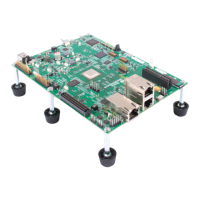Configuring DSP/BIOS Applications Statically
Program Generation 2-11
2.3 Configuring DSP/BIOS Applications Statically
As Section 1.2.2, DSP/BIOS Configuration Tool, page 1-6 describes,
DSP/BIOS configurations allow you create objects and set their properties
statically, rather than at run-time. You can choose to create a configuration
graphically, textually, or using a combination of these methods.
The DSP/BIOS Textual Configuration (Tconf) User’s Guide (SPRU007)
contains details on the syntax used in configuration scripts.
2.3.1 When to Use Graphical Configuration
Use the DSP/BIOS Configuration Tool for the following advantages:
❏ If you want a tree-view interface that makes it easy to see the available
properties for each module and object.
❏ If you want to be prevented from making errors by the interface, which
provides drop-down lists of valid values and disables invalid commands
and fields.
You can use a text editor to modify a configuration script and then reload the
script into the DSP/BIOS Configuration Tool for further graphical editing.
There are certain restrictions on graphical editing after you have edited a
script or started a new configuration session.
2.3.2 When to Use a Text Editor
Use a text editor to modify a script if you want the following advantages:
❏ If you want a script to use branching, looping, and other constructs.
❏ If you want to create a number of similar objects. You can do this with cut-
and-paste or by looping over a create method.
❏ If you want to modularize settings you use in a set of applications. For
example, if your applications all use similar instrumentation objects, all
applications can include a single file that creates those objects.
❏ If you want the configuration to use the same symbol definitions as
program source files. You can do this by defining variables for use in
scripts and generating a C header file from the script to be included by
the program source code.
❏ If you want to create similar configurations, you can pass command-line
arguments to a script. For example, you might optimize a program by
varying the number of tasks created and testing resulting applications.

